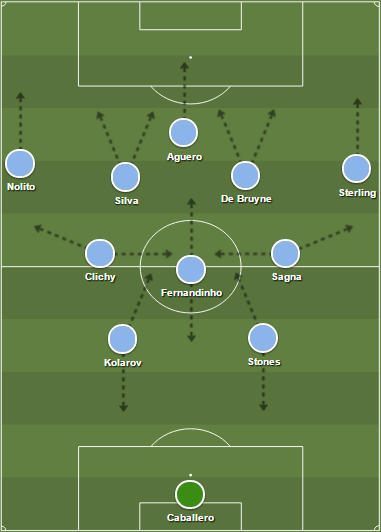A penalty and an own goal were just enough to kickstart Pep Guardiola’s Manchester City career with a “not so convincing” win. The Etihad side dominated the match with almost 77% of possession and a complete domination through the course of the game but they were rarely ruthless in the final third of the pitch.
Apart from domination of possession, the former Bayern Munich manager introduced his new tactical masterpiece to the Premier League. His side was initially introduced to the media as 4-1-4-1 formation with Alexander Kolarov partnering new signing John Stones at center back and both Raheem Sterling and Nolito out wide. Kevin de Bruyne and skipper David Silva were the two men behind lone striker Sergio Agüero.
Well, that initially looked so as Pep had to shuffle things around to introduce his tactical mindset to the English game as his side switched between 2-3-4-1 and 2-3-2-3 every now and then having both Stones and Kolarov at the Etihad half with both full backs Gaël Clichy and Bacary Sagna pushing down the flanks, and in central areas with Brazilian midfielder Fernandinho. Switching between 4-1 and 2-3 in the final third was an attempt to break David Moyes’ defensive discipline by providing Agüero with extra support upfront.
Guardiola’s comments during preseason indicated that Fernandinho can play as a center back as the understanding between the Brazilian and the former Everton man, Stones, was very important in covering their positions when one player had to advance to help the team in initiating attacks.

Tactical advantages
Despite the complete domination of the game, the main question remains: Will the former Barcelona manager stick with this system for the rest of the season?
It’s no issue that the team will have to get used to this system as it’s completely new and could take some time for them to adapt to Pep’s ideas, but once the team gets used to it, Manchester City will have the advantage of pressing in the opponents’ half with around eight players, resulting in creating both space and chances in the final third.
One important advantage also lies in retaining possession where the team was able to win the ball back within seconds against Sunderland.

Tactical disadvantages
This system requires fast players at the back and deploying Kolarov as a center back is only an advantage to the team. But what happens when Vincent Kompany returns from his injury? He could act as a sweeper, giving Stones the chance to advance further upfield or Guardiola could switch back to his classical 4-3-3 or 3-4-3.
The Spaniard’s new system could see his team struggling when playing away from the Etihad stadium or when facing more physical or paced teams as opponents could find it easier to penetrate and find spaces at the back.
Conclusion
The Premier League was introduced to a whole new set of tactical lessons by Guardiola. This is a new chapter for Manchester City as both the coaching staff and players will need time to reflect them on the pitch. When the new signings get used to the club and their new life in Manchester, and when the existing players understand and apply the new ideas, we could see some exciting and a new dimension of football at the Etihad.
On the other hand, Pep should be flexible enough to switch between his tactics according to rhythm and inputs of the Premier League, an environment which is completely new to him.






































